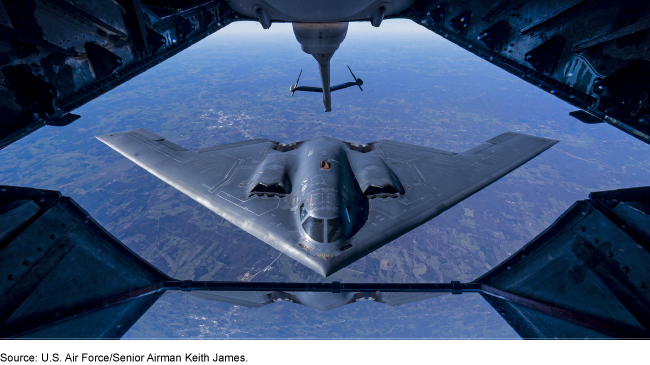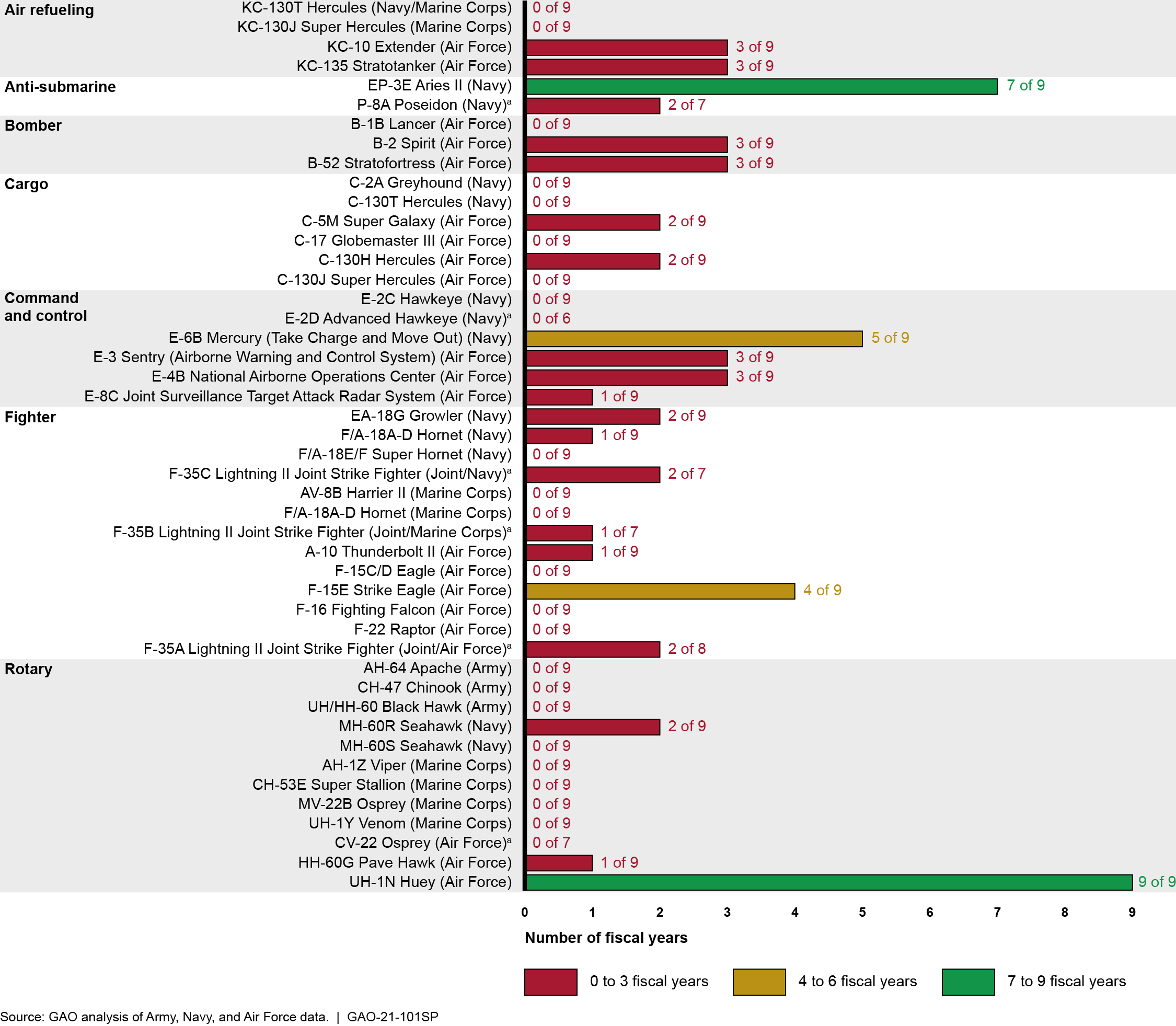Weapon System Sustainment: Aircraft Mission Capable Rates Generally Did Not Meet Goals and Cost of Sustaining Selected Weapon Systems Varied Widely
Fast Facts
One measure of the health and readiness of a military aircraft fleet is the mission capable rate—the percentage of total time aircraft can fly and perform at least one mission.
We examined whether 46 types of aircraft met their annual mission capable goals for FYs 2011-2019. We found:
3 met their goals in a majority of the years
24 did not meet their goals in any year
We also reviewed annual operating and support costs for these aircraft, such as maintenance costs. These costs totaled over $49 billion in FY 2018, ranging from $118 million for the Navy's KC-130T Hercules to $4.2 billion for the Air Force's KC-135 Stratotanker.
An Air Force KC-10 Extender tanker preparing to refuel an Air Force B-2 Spirit Bomber — both of which met readiness goals in 3 of the 9 years we examined.

Highlights
Mission Capable Rates for Selected Department of Defense Aircraft
GAO examined 46 types of aircraft and found that only three met their annual mission capable goals in a majority of the years for fiscal years 2011 through 2019 and 24 did not meet their annual mission capable goals in any fiscal year as shown below. The mission capable rate—the percentage of total time when the aircraft can fly and perform at least one mission—is used to assess the health and readiness of an aircraft fleet.
Number of Times Selected Aircraft Met Their Annual Mission Capable Goal, Fiscal years 2011 through 2019

aThe military departments did not provide mission capable goals for all nine years for these aircraft.
Aggregating the trends at the military service level, the average annual mission capable rate for the selected Air Force, Navy, and Marine Corps aircraft decreased since fiscal year 2011, while the average annual mission capable rate for the selected Army aircraft slightly increased. While the average mission capable rate for the F-35 Lightning II Joint Strike Fighter showed an increase from fiscal year 2012 to 2019, it trended downward from fiscal year 2015 through fiscal year 2018 before improving slightly in fiscal year 2019.
For fiscal year 2019, GAO found only three of the 46 types of aircraft examined met the service-established mission capable goal. Furthermore, for fiscal year 2019:
- six aircraft were 5 percentage points or fewer below the goal;
- 18 were from 15 to 6 percentage points below the goal; and
- 19 were more than 15 percentage points below the goal, including 11 that were 25 or more percentage points below the goal.
Program officials provided various reasons for the overall decline in mission capable rates, including aging aircraft, maintenance challenges, and supply support issues as shown below.
Sustainment Challenges Affecting Some of the Selected Department of Defense Aircraft

aA service life extension refers to a modification to extend the service life of an aircraft beyond what was planned.
bDiminishing manufacturing sources refers to a loss or impending loss of manufacturers or suppliers of items.
cObsolescence refers to a lack of availability of a part due to its lack of usefulness or its no longer being current or available for production.
Operating and Support Costs for Selected Department of Defense Aircraft
Operating and support (O&S) costs, such as the costs of maintenance and supply support, totaled over $49 billion in fiscal year 2018 for the aircraft GAO reviewed and ranged from a low of $118.03 million for the KC-130T Hercules (Navy) to a high of $4.24 billion for the KC-135 Stratotanker (Air Force). The trends in O&S costs varied by aircraft from fiscal year 2011 to 2018. For example, total O&S costs for the F/A-18E/F Super Hornet (Navy) increased $1.13 billion due in part to extensive maintenance needs. In contrast, the F-15C/D Eagle (Air Force) costs decreased by $490 million due in part to a reduction in the size of the fleet. Maintenance-specific costs for the aircraft types we examined also varied widely.
Why This Matters
The Department of Defense (DOD) spends tens of billions of dollars annually to sustain its weapon systems in an effort to ensure that these systems are available to simultaneously support today's military operations and maintain the capability to meet future defense requirements. This report provides observations on mission capable rates and costs to operate and sustain 46 fixed- and rotary-wing aircraft in the Departments of the Army, Navy, and Air Force.
How GAO Did This Study
GAO was asked to report on the condition and costs of sustaining DOD's aircraft. GAO collected and analyzed data on mission capable rates and O&S costs from the Departments of the Army, Navy, and Air Force for fiscal years 2011 through 2019. GAO reviewed documentation and interviewed program office officials to identify reasons for the trends in mission capability rates and O&S costs as well as any challenges in sustaining the aircraft. This is a public version of a sensitive report issued in August 2020. Information on mission capable and aircraft availability rates were deemed to be sensitive and has been omitted from this report.
For more information, contact Director Diana Maurer at (202) 512-9627 or maurerd@gao.gov.
